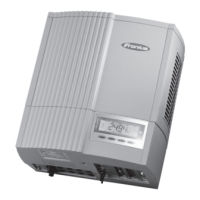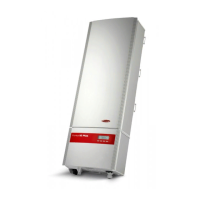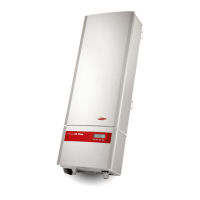Do you have a question about the Fronius IG 20 and is the answer not in the manual?
Explanation of DANGER!, WARNING!, CAUTION!, and NOTE! signal words for hazard identification.
General safety guidelines and principles for operating and maintaining the equipment.
Guidelines for safe installation, airflow, and information on noise emission values.
Procedures for diagnosing faults and interpreting service codes.
Essential safety rules and guidelines for accessing the housing unit.
Explanation of galvanic insulation and the inverter's mains network monitoring functions.
Guidelines for connecting solar modules and the public mains network safely.
Safe procedures for connecting and disconnecting DC and AC plugs.
Describes the FRONIUS IG as a link between solar modules and the grid, converting DC to AC.
Explains the fully automatic operation and Maximum Power Point Tracking (MPPT) function.
Details voltage transformation, galvanic insulation, and safety aspects of the unit.
Explains how the FRONIUS IG monitors the mains network for protection and stability.
Explains how the FRONIUS IG unit operates automatically and its main functions.
Details the startup sequence, including self-tests and network synchronization.
Describes mains synchronization, startup tests, and ENS synchronization procedures.
Explains the meaning of different LED colors (green, orange, red) for operational status.
Details LED behavior for warnings, standby, and no power output conditions.
Instructions for fixing the wall mounting frame for indoor FRONIUS IG units.
Steps for mounting the FRONIUS IG Outdoors unit using the wall bracket.
Important points for connecting solar modules and the public mains network.
Guidance on connecting multiple FRONIUS IG units in parallel for larger systems.
Recommendations for AC-side overcurrent protection, including fuse and circuit breaker types.
Detailed instructions for making connections using the terminal block within the housing.
Instructions for connecting solar modules using DC plugs, ensuring correct polarity.
Procedure for connecting the unit to the public mains using an AC plug.
Steps for connecting the outdoor unit, including terminal block and strain relief.
Information on the factory pre-configured settings and initial startup.
Guidance for personal configuration settings and network setup.
Explains how the unit displays service codes for diagnosing faults.
Details common service codes like DCLOW and POWER LOW.
Steps to diagnose complete unit failures and check no-load voltage.
Procedure for diagnosing errors in units with multiple power stage sets.
Explanation of DANGER!, WARNING!, CAUTION!, and NOTE! signal words for hazard identification.
General safety guidelines and principles for operating and maintaining the equipment.
Guidelines for safe installation, airflow, and information on noise emission values.
Procedures for diagnosing faults and interpreting service codes.
Essential safety rules and guidelines for accessing the housing unit.
Explanation of galvanic insulation and the inverter's mains network monitoring functions.
Guidelines for connecting solar modules and the public mains network safely.
Safe procedures for connecting and disconnecting DC and AC plugs.
Describes the FRONIUS IG as a link between solar modules and the grid, converting DC to AC.
Explains the fully automatic operation and Maximum Power Point Tracking (MPPT) function.
Details voltage transformation, galvanic insulation, and safety aspects of the unit.
Explains how the FRONIUS IG monitors the mains network for protection and stability.
Explains how the FRONIUS IG unit operates automatically and its main functions.
Details the startup sequence, including self-tests and network synchronization.
Describes mains synchronization, startup tests, and ENS synchronization procedures.
Explains the meaning of different LED colors (green, orange, red) for operational status.
Details LED behavior for warnings, standby, and no power output conditions.
Instructions for fixing the wall mounting frame for indoor FRONIUS IG units.
Steps for mounting the FRONIUS IG Outdoors unit using the wall bracket.
Important points for connecting solar modules and the public mains network.
Guidance on connecting multiple FRONIUS IG units in parallel for larger systems.
Recommendations for AC-side overcurrent protection, including fuse and circuit breaker types.
Detailed instructions for making connections using the terminal block within the housing.
Instructions for connecting solar modules using DC plugs, ensuring correct polarity.
Procedure for connecting the unit to the public mains using an AC plug.
Steps for connecting the outdoor unit, including terminal block and strain relief.
Information on the factory pre-configured settings and initial startup.
Guidance for personal configuration settings and network setup.
Explains how the unit displays service codes for diagnosing faults.
Details common service codes like DCLOW and POWER LOW.
Steps to diagnose complete unit failures and check no-load voltage.
Procedure for diagnosing errors in units with multiple power stage sets.











